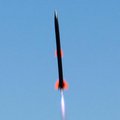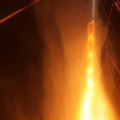Hi @Kip Daugirdas! Welcome aboard!
![]() my question :) - how people decide between liquid fuel and solid fuel rockets, especially for big ones?
my question :) - how people decide between liquid fuel and solid fuel rockets, especially for big ones?
 Good question -- we'll get started in about 20 minutes, I'm sure there'll be an answer. My guess is it's a tradeoff between complexity and power, with maybe the ability to throttle tossed in too.
Good question -- we'll get started in about 20 minutes, I'm sure there'll be an answer. My guess is it's a tradeoff between complexity and power, with maybe the ability to throttle tossed in too.
 Be curious about that too, n2o is stored in liquid form right?
Be curious about that too, n2o is stored in liquid form right?

 OK folks, welcome to the penultimate Hack Chat of 2022! I'm Dan, and Dusan and I will be modding today as we welcome Kip Daugirdas to talk about amateur rocketry. I'm quite excited for this one -- love me some rockets!
OK folks, welcome to the penultimate Hack Chat of 2022! I'm Dan, and Dusan and I will be modding today as we welcome Kip Daugirdas to talk about amateur rocketry. I'm quite excited for this one -- love me some rockets!
 Hi Kip -- saw you on before, you still there?
Hi Kip -- saw you on before, you still there?
![]() yeah I am here
yeah I am here
 Good, good -- welcome! Maybe you can start us off with a little about how you got into rocketry on this scale?
Good, good -- welcome! Maybe you can start us off with a little about how you got into rocketry on this scale?

https://www.youtube.com/watch?v=4QsEPEhq5yk
 This is the scale I'm talking about, in case you don't know what Kip has recently accomplished
This is the scale I'm talking about, in case you don't know what Kip has recently accomplished
![]() Sure. I started with high power rocket back in the early 00's (in high school). Went on to study aerospace engineering and then continued to participate in amatuer rocketry as a hobby.
Sure. I started with high power rocket back in the early 00's (in high school). Went on to study aerospace engineering and then continued to participate in amatuer rocketry as a hobby.
![]() so i have been at it while
so i have been at it while
![]() a while*
a while*
 What about getting the proper BATF Licenses to manufacture Rocket Fuel? Once you go big you.. go big.
What about getting the proper BATF Licenses to manufacture Rocket Fuel? Once you go big you.. go big.
![]() in general, licensing work, all kinds of permissions... that's a lot, and rather orthogonal to technology
in general, licensing work, all kinds of permissions... that's a lot, and rather orthogonal to technology
![]() To answer the question about solid vs. liquid propellants (fuel is one propellant, oxidizer is another), solids are simpler. Liquids require plumbing.
To answer the question about solid vs. liquid propellants (fuel is one propellant, oxidizer is another), solids are simpler. Liquids require plumbing.
![]() to answer the first question regarding liquids versus solids. Solid are far simpler and have a much higher propellant density. This means you can pack more impulse into a smaller package.
to answer the first question regarding liquids versus solids. Solid are far simpler and have a much higher propellant density. This means you can pack more impulse into a smaller package.
![]() ammonium perchlorate is not a regulated substance in the U.S. so no permits from the ATF are required to store or make rocket fuel for individual use. However, you do need to be at least Level 2 certified to fly experimental rocket motors at Tripoli rocket launches.
ammonium perchlorate is not a regulated substance in the U.S. so no permits from the ATF are required to store or make rocket fuel for individual use. However, you do need to be at least Level 2 certified to fly experimental rocket motors at Tripoli rocket launches.
 Thank you so Tripoli is the authority in this case?
Thank you so Tripoli is the authority in this case?
 isnt perchlorate incredibly toxic to humans
isnt perchlorate incredibly toxic to humans
 Could you expand on what Tripoli is for those of us newer to this.
Could you expand on what Tripoli is for those of us newer to this.
![]() Yeah we are essentially self governed. Tripoli worked really hard to get AP off of the ATF explosives list.
Yeah we are essentially self governed. Tripoli worked really hard to get AP off of the ATF explosives list.
 Oxidizer used N2O?
Oxidizer used N2O?
![]() in some rocket communities we've talked about liquids vs. solids. Common opinion was that as soon as solids become large, they become more dangerous - you don't control quality that well, and oxidizer is close to fuel in the charge, so if it starts, it's pretty dangerous. While liquids generally benign before they get in contact. I should admit I like working with peroxide (HTP), and that requires respect - HTP can decompose, but it seems a simpler chemistry, more controllable (just pure peroxide). So to get high impulse, it felt liquids - mechanically harder, but chemically easier - could be safer for amateurs.
in some rocket communities we've talked about liquids vs. solids. Common opinion was that as soon as solids become large, they become more dangerous - you don't control quality that well, and oxidizer is close to fuel in the charge, so if it starts, it's pretty dangerous. While liquids generally benign before they get in contact. I should admit I like working with peroxide (HTP), and that requires respect - HTP can decompose, but it seems a simpler chemistry, more controllable (just pure peroxide). So to get high impulse, it felt liquids - mechanically harder, but chemically easier - could be safer for amateurs.
![]() Tripoli is a national organization for high power rocketry meaning anything larger than a G-motor. There are local clubs in every state in the US and there are even some international prefectures. Learn more at www.tripoli.org
Tripoli is a national organization for high power rocketry meaning anything larger than a G-motor. There are local clubs in every state in the US and there are even some international prefectures. Learn more at www.tripoli.org
 What do you use to ignite the chemicals? nichrome?
What do you use to ignite the chemicals? nichrome?
![]() The proper term is ammonium perchlorate composite propellant, APCP. I was on the Tripoli Rocketry Association's BoD during the eleven-year battle to remove APCP from the explosives list.
The proper term is ammonium perchlorate composite propellant, APCP. I was on the Tripoli Rocketry Association's BoD during the eleven-year battle to remove APCP from the explosives list.
 H.....mmmm..... A thought just struck me, I've still got 9lbs of Triple refined Mercury... Ideas?
H.....mmmm..... A thought just struck me, I've still got 9lbs of Triple refined Mercury... Ideas?
![]() Mercury has no significant use in amateur rocketry. In fact, it's extremely difficult to ship any more.
Mercury has no significant use in amateur rocketry. In fact, it's extremely difficult to ship any more.
![]() Ignition of the rocket motors is done electronically via an electric match. So yes nichrome wire qualifies as an ignition method.
Ignition of the rocket motors is done electronically via an electric match. So yes nichrome wire qualifies as an ignition method.
 The other (US-based) organization for rocketry is NAR (www.nar.org) - the National Association of Rocketry. Less focus on amateur-level projects, but still supports and regulates high-power rocketry.
The other (US-based) organization for rocketry is NAR (www.nar.org) - the National Association of Rocketry. Less focus on amateur-level projects, but still supports and regulates high-power rocketry.
 So really just a scaled-up Estes rocket then? Biggest I ever flew was a D motor, BTW
So really just a scaled-up Estes rocket then? Biggest I ever flew was a D motor, BTW
![]() Ammonium perchlorate is definitetly not the cleanest (enviromental wise) rocket propellant.
Ammonium perchlorate is definitetly not the cleanest (enviromental wise) rocket propellant.
 And no offense meant by "just", of course
And no offense meant by "just", of course
![]() I'm sure after such a successful flight (89+ km, that's beautiful) there are future plans, right?
I'm sure after such a successful flight (89+ km, that's beautiful) there are future plans, right?
 Any experience with hybrid rocket motors?
Any experience with hybrid rocket motors?
![]() I plan to fly the rocket again next summer/fall. And hopefully start working on plans for a better upper stage motor.
I plan to fly the rocket again next summer/fall. And hopefully start working on plans for a better upper stage motor.
 @Dan Maloney you definitely need different materials - cardboard and balsa give way to fiberglass at a certain impulse
@Dan Maloney you definitely need different materials - cardboard and balsa give way to fiberglass at a certain impulse
![]() I have very little experience in hybrid motors. I made a few in college - they didn't perform that great
I have very little experience in hybrid motors. I made a few in college - they didn't perform that great
![]() Perchlorates can be a problem in that they can substitute for iodine in the thyroid. However, they are routinely shipped Hazmat like many other chemicals. No, they will not kill you if they get on the skin; in fact, years ago small amounts of perchlorates were fed to cattle, I believe it accelerated growth. As a retired chem prof I'd rate concentrated sulfuric and nitric acids as far more hazardous to use than perchlorates.
Perchlorates can be a problem in that they can substitute for iodine in the thyroid. However, they are routinely shipped Hazmat like many other chemicals. No, they will not kill you if they get on the skin; in fact, years ago small amounts of perchlorates were fed to cattle, I believe it accelerated growth. As a retired chem prof I'd rate concentrated sulfuric and nitric acids as far more hazardous to use than perchlorates.
![]() better upper stage - for the same lower stage? Is the goal to cross 100 km height?
better upper stage - for the same lower stage? Is the goal to cross 100 km height?
 Oh no RFNA!
Oh no RFNA!
![]() There is at least one company that makes hybrid high-power motors. Nitrous oxide is the oxidizer, plastic tubing is the fuel.
There is at least one company that makes hybrid high-power motors. Nitrous oxide is the oxidizer, plastic tubing is the fuel.
![]() I would like to develop what is called an end burning grain geometry. Similar to what used on a small retired sounding rocket called the Arcas. A longer burn will lower the drag total drag on the upper stage by allowing it get to even higher altitudes before the motor burns out.
I would like to develop what is called an end burning grain geometry. Similar to what used on a small retired sounding rocket called the Arcas. A longer burn will lower the drag total drag on the upper stage by allowing it get to even higher altitudes before the motor burns out.
 Hybrids are possibly safer although VG did have those casualties when ground testing their N2O systems.
Hybrids are possibly safer although VG did have those casualties when ground testing their N2O systems.
 Hey Kip! Charles from Half Cat Rocketry here. In the video from Project Mesos, it looked like the aftermarket lenses were glued onto the GoPro cameras. Did you purchase pre-modified cameras, or retrofit them yourself? If so, any resources you can point me to on making those mods? The video quality was incredible, and we’d like to achieve something similar for the 50k+ ft launch of our Full Cat rocket. Thanks!
Hey Kip! Charles from Half Cat Rocketry here. In the video from Project Mesos, it looked like the aftermarket lenses were glued onto the GoPro cameras. Did you purchase pre-modified cameras, or retrofit them yourself? If so, any resources you can point me to on making those mods? The video quality was incredible, and we’d like to achieve something similar for the 50k+ ft launch of our Full Cat rocket. Thanks!
 @Kip Daugirdas is the end-burner for the booster or sustainer?
@Kip Daugirdas is the end-burner for the booster or sustainer?
![]() Anyone thinking of using hydrogen peroxide as a monopropellant or as an oxidizer in very-large-scale rockets should read Clark's "Ignition", where he describes it as "always a bridesmaid, never a bride."
Anyone thinking of using hydrogen peroxide as a monopropellant or as an oxidizer in very-large-scale rockets should read Clark's "Ignition", where he describes it as "always a bridesmaid, never a bride."
![]() The Arcas was a 4.5" diameter rocket ~ 6ft tall and could fly to over 200,000 ft as a single stage. With a first stage booster is could reach altitude well over 100 km
The Arcas was a 4.5" diameter rocket ~ 6ft tall and could fly to over 200,000 ft as a single stage. With a first stage booster is could reach altitude well over 100 km
![]() @dunedain289 second stage
@dunedain289 second stage
 i bought a tiny microhybrid rocket engine, but never got that to work alas. What kind of electronics does your rocket have out of interest? Camera/altimeter/..?
i bought a tiny microhybrid rocket engine, but never got that to work alas. What kind of electronics does your rocket have out of interest? Camera/altimeter/..?
![]() so it's technology development, great. I'm asking because if there are orbital plans, it would be interesting to see to get to orbit with solids. Should it follow the SS-520 approach, or it could be something else?
so it's technology development, great. I'm asking because if there are orbital plans, it would be interesting to see to get to orbit with solids. Should it follow the SS-520 approach, or it could be something else?
![]() Two issues with endburning propellant grains (burns from one end to the other like a cigarette): a rather fast-burning propellant is needed; APCP typically burns at about 0.25"/second, while a good propellant for endburners should burn about three times as fast. There's also the issue with insulation. The bottom of the motor case is exposed to hot gases for the entire length of the burn.
Two issues with endburning propellant grains (burns from one end to the other like a cigarette): a rather fast-burning propellant is needed; APCP typically burns at about 0.25"/second, while a good propellant for endburners should burn about three times as fast. There's also the issue with insulation. The bottom of the motor case is exposed to hot gases for the entire length of the burn.
 I was going to ask about orbital aspirations -- as an outsider, it seems an obvious goal for an amateur to deliver a payload to orbit. Is that possible/legal? Has it been done already?
I was going to ask about orbital aspirations -- as an outsider, it seems an obvious goal for an amateur to deliver a payload to orbit. Is that possible/legal? Has it been done already?
![]() @prfesser , I've read the Clark. I'd also recommend this old letter - https://yarchive.net/space/rocket/fuels/peroxide.html - with part
@prfesser , I've read the Clark. I'd also recommend this old letter - https://yarchive.net/space/rocket/fuels/peroxide.html - with part
(Even _Ignition!_, while pretty sour on hydrogen peroxide due
to the decomposition hazard, has the facts right, and only the emphasis is
arguable -- I don't understand how someone can cozy up to ClF5 while
considering peroxide dangerous; but that was Clark's position! )
![]() @anfractuosity the rocket used OTS flight computers designed for amatuer rockets. The two flight computers used were a Featherweight Raven 4 and a Multitronix Kate 3.0. The cameras were modified GoPro Hero 9s. The modification were done by Backbone, a canadian company. www.back-bone.ca
@anfractuosity the rocket used OTS flight computers designed for amatuer rockets. The two flight computers used were a Featherweight Raven 4 and a Multitronix Kate 3.0. The cameras were modified GoPro Hero 9s. The modification were done by Backbone, a canadian company. www.back-bone.ca
 If only a second hand SLS solid were available wonder if one could be moded to fly by itself would it reach orbit?
If only a second hand SLS solid were available wonder if one could be moded to fly by itself would it reach orbit?
![]() Orbiting a payload is not twice as hard as sending one to 100 km. More like 20 times as hard.
Orbiting a payload is not twice as hard as sending one to 100 km. More like 20 times as hard.
 thanks, will have a look at those computers
thanks, will have a look at those computers
![]() I have no plans to go orbital. I think that would be a pretty impossible task for an amateur.
I have no plans to go orbital. I think that would be a pretty impossible task for an amateur.
 not with that altitude
not with that altitude
 Orbital also raises a terrifying amount of safety concerns, since you'd need active guidance (enjoy arms control regulations), and your rocket needs many times more horizontal thrust, so now you can't stay within a small launch range
Orbital also raises a terrifying amount of safety concerns, since you'd need active guidance (enjoy arms control regulations), and your rocket needs many times more horizontal thrust, so now you can't stay within a small launch range
![]() Dan Maloney's question is interesting as only a handful of amateur scientist have been able to launch micro-satellites as part of a large mission. I am assuming it is still cost prohibitive.
Dan Maloney's question is interesting as only a handful of amateur scientist have been able to launch micro-satellites as part of a large mission. I am assuming it is still cost prohibitive.
![]() It's not so much that peroxide is inherently dangerous, just that it decomposes in contact with...almost everything. Most metals, especially metal oxides. Dirt... Also, getting 90%+ pure peroxide in quantity is something of an issue.
It's not so much that peroxide is inherently dangerous, just that it decomposes in contact with...almost everything. Most metals, especially metal oxides. Dirt... Also, getting 90%+ pure peroxide in quantity is something of an issue.
 dont most gps's stop working after a certain height?
dont most gps's stop working after a certain height?
 Any amateurs doing Rockoons systems?
Any amateurs doing Rockoons systems?
![]() @prfesser yeah the insulation and the burn rate are going to be tricky to acheive but I have some ideas which I plan to try out this summer. It will definitely be a multi-year project just to develop the motor.
@prfesser yeah the insulation and the burn rate are going to be tricky to acheive but I have some ideas which I plan to try out this summer. It will definitely be a multi-year project just to develop the motor.
 @zombodotcom yeah i think there's an altitude and velocity statement threshold in the gps chip
@zombodotcom yeah i think there's an altitude and velocity statement threshold in the gps chip
![]() @kjansky1 rockoons are a great idea. Problem is limiting the dispersion of the rocket. The FAA gives us rather small cylinders that the rockets need to stay in. For example the one we had at Black Rock was 15 NM radius up to 350,000 ft.
@kjansky1 rockoons are a great idea. Problem is limiting the dispersion of the rocket. The FAA gives us rather small cylinders that the rockets need to stay in. For example the one we had at Black Rock was 15 NM radius up to 350,000 ft.
![]() The GPS on the Multitronix Kate flight computer has a GPS chip which is unlocked for altitude but not velocity. It still locks out when the rocket is travelling over 500 m/s
The GPS on the Multitronix Kate flight computer has a GPS chip which is unlocked for altitude but not velocity. It still locks out when the rocket is travelling over 500 m/s
![]() Oxidizers other than ammonium perchlorate have their own problems. Ammonium nitrate requires either a lot of burn rate catalyst, or a lot of magnesium powder, to get a decent burn rate. Even then, it's slow-burning compared to APCP. And it's very hygroscopic, and undergoes a solid phase change around 90F which can cause storage issues. There are some more exotic oxidizers being studied but most of them either decompose too readily in contact with fuels, and/or are outrageously expensive (over $1k/lb).
Oxidizers other than ammonium perchlorate have their own problems. Ammonium nitrate requires either a lot of burn rate catalyst, or a lot of magnesium powder, to get a decent burn rate. Even then, it's slow-burning compared to APCP. And it's very hygroscopic, and undergoes a solid phase change around 90F which can cause storage issues. There are some more exotic oxidizers being studied but most of them either decompose too readily in contact with fuels, and/or are outrageously expensive (over $1k/lb).
 Paul Breed of Unreasonable Rocket had a license to distill H2O2 for 90%+ he did that out in a desert facility.
Paul Breed of Unreasonable Rocket had a license to distill H2O2 for 90%+ he did that out in a desert facility.
 Do you have to explosively eject a parachute out of interest? (i've only used model rockets where the cone pops off and the parachute comes out itself)
Do you have to explosively eject a parachute out of interest? (i've only used model rockets where the cone pops off and the parachute comes out itself)
![]() @anfractuosity yep black powder is still used to seperate the rocket at apogee. Just like a model rocket
@anfractuosity yep black powder is still used to seperate the rocket at apogee. Just like a model rocket
![]() Distilling peroxide is something I'd personally avoid--and I've handled literally thousands of pounds of ammonium perchlorate and APCP over the years. Distilling it in quantities needed for large-scale (suborbital or orbital rocketry) is a project in itself. One would spend most of one's time distilling chemicals rather than working on a rocket.
Distilling peroxide is something I'd personally avoid--and I've handled literally thousands of pounds of ammonium perchlorate and APCP over the years. Distilling it in quantities needed for large-scale (suborbital or orbital rocketry) is a project in itself. One would spend most of one's time distilling chemicals rather than working on a rocket.
![]() FWIW there is a second edition (July 2021) of a book on how to make APCP and design and build small (G thru M impulse) motors. However, anyone thinking of doing so should first get a LOT of experience building and flying commercial motors. Need to understand different grain geometries, nozzle construction and its relationship to burning propellant surface area.
FWIW there is a second edition (July 2021) of a book on how to make APCP and design and build small (G thru M impulse) motors. However, anyone thinking of doing so should first get a LOT of experience building and flying commercial motors. Need to understand different grain geometries, nozzle construction and its relationship to burning propellant surface area.
![]() @prfesser I have to agree. There are so many things you have to build that are not the rocket to complete a project like this. Launch pad, machining fixtures, test stand, data aquisition equiptment, etc. Then there's the repitition of motor and flight testing.
@prfesser I have to agree. There are so many things you have to build that are not the rocket to complete a project like this. Launch pad, machining fixtures, test stand, data aquisition equiptment, etc. Then there's the repitition of motor and flight testing.
![]() I'd consider making a peroxide distiller a simpler project than a decent rocket. We've made (not in the US) a 1-liter-per-hour distiller - rather small, yes, but could certainly be used for launching a subsonic rocket. There were some encouraging experiments with peroxide freezing as well...
I'd consider making a peroxide distiller a simpler project than a decent rocket. We've made (not in the US) a 1-liter-per-hour distiller - rather small, yes, but could certainly be used for launching a subsonic rocket. There were some encouraging experiments with peroxide freezing as well...
![]() Someone want to learn hacking and use discord ?
Someone want to learn hacking and use discord ?
 So it sounds like there's a significant regulatory regime you've got to deal with. Any way to avoid entanglements with the alphabet agencies (FAA, ATF, etc.)?
So it sounds like there's a significant regulatory regime you've got to deal with. Any way to avoid entanglements with the alphabet agencies (FAA, ATF, etc.)?
 Did you say you make the motor yourself I might have missed that?
Did you say you make the motor yourself I might have missed that?
 @Backroom - This probably isn't the kind of hacking you're thinking of.
@Backroom - This probably isn't the kind of hacking you're thinking of.
![]() @anfractuosity yes the motors for this flight were designed and built by me
@anfractuosity yes the motors for this flight were designed and built by me
 Cool :) So Ammonium perchlorate is an oxidiser? what else do you use to make the motor?
Cool :) So Ammonium perchlorate is an oxidiser? what else do you use to make the motor?
![]() @Dan Maloney honestly dealing with the regulatory agencies is rather simple - especially if you fly your projects at Tripoli sponsored launches.
@Dan Maloney honestly dealing with the regulatory agencies is rather simple - especially if you fly your projects at Tripoli sponsored launches.
![]() To answer a question, N2O oxidizer is indeed stored as a liquid. A hybrid rocket using N2O would probably be substantially cheaper to fly than a solid propellant motor. N2O is less expensive per pound than the ingredients for APCP. Aerotech's hybrid motor (out of stock) used paper tubing as the fuel.
To answer a question, N2O oxidizer is indeed stored as a liquid. A hybrid rocket using N2O would probably be substantially cheaper to fly than a solid propellant motor. N2O is less expensive per pound than the ingredients for APCP. Aerotech's hybrid motor (out of stock) used paper tubing as the fuel.
![]() Oh i see... U r talking about motors
Oh i see... U r talking about motors
![]() APCP propellant used for this project consisted of AP, Aluminum powder and a rubber binder. The solids content was 82% and the liquids (binder) was the remaining 18>#/span###
APCP propellant used for this project consisted of AP, Aluminum powder and a rubber binder. The solids content was 82% and the liquids (binder) was the remaining 18>#/span###
 Neat, you don't have to grind the AP or anything do you?
Neat, you don't have to grind the AP or anything do you?
![]() @Kip Daugirdas , this last attempt - what was the hardest part?
@Kip Daugirdas , this last attempt - what was the hardest part?
![]() No I purchase different mesh sizes. The sizes vary from regular table sugar to powder sugar for the AP. The aluminum is also a blend of different sizes. The shape of the particles is very important because you want to be able to pour the propellant into the molds. Remember the mixture is 82% solids so acheiving a pourable mixture is quite difficult
No I purchase different mesh sizes. The sizes vary from regular table sugar to powder sugar for the AP. The aluminum is also a blend of different sizes. The shape of the particles is very important because you want to be able to pour the propellant into the molds. Remember the mixture is 82% solids so acheiving a pourable mixture is quite difficult
 So did the flight reach the Karman line?
So did the flight reach the Karman line?
![]() There is a project called "Sugar Shot to Space" which is attempting to make a potassium nitrate + sugar rocket that will reach 100 km. They're doing a pretty good job of it. Right now they're making 12" diameter propellant grains for a test.
There is a project called "Sugar Shot to Space" which is attempting to make a potassium nitrate + sugar rocket that will reach 100 km. They're doing a pretty good job of it. Right now they're making 12" diameter propellant grains for a test.
 Is sugar the best fuel for motor or just easier to manufacture with.
Is sugar the best fuel for motor or just easier to manufacture with.
![]() @Alex Mi I would say it was the amount of time I had to dedicate to the project - particularly the 10 or so months before the launch. My days often followed the trend of 8 hours at work doing my day job, followed by 8 hours at home working on the rocket. Weekends were often 16 hour days....
@Alex Mi I would say it was the amount of time I had to dedicate to the project - particularly the 10 or so months before the launch. My days often followed the trend of 8 hours at work doing my day job, followed by 8 hours at home working on the rocket. Weekends were often 16 hour days....
 wow!
wow!
![]() And all of this was for a project that had a high likelihood of failure.
And all of this was for a project that had a high likelihood of failure.
![]() Trust me I questioned why I was doing this often.
Trust me I questioned why I was doing this often.

 Dan Maloney
Dan Maloney
Discussions
Become a Hackaday.io Member
Create an account to leave a comment. Already have an account? Log In.